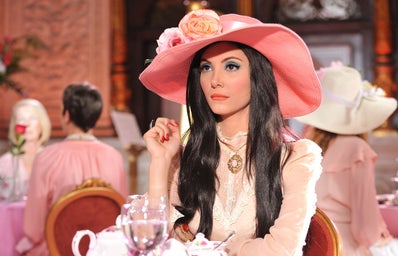Due to its limited release in the U.S. in November 2016 after premiering at the International Film Festival Rotterdam, you’ll be forgiven if you haven’t seen The Love Witch. Although Anna Biller’s glorious Technicolor production has received a great deal of critical attention, the average filmgoer has most likely never even heard of it.
A horror comedy written, directed, edited, produced, and scored by Anna Biller, The Love Witch, follows Elaine Parks (Samantha Robinson), a modern-day witch who uses spells and potions to make men fall in love with her, with successfully disastrous results. When the men she seduces end up dead after succumbing entirely to her powerful, dangerous love magic, Elaine raises the suspicions of local police, leading her to find her true lover, insanity, and murder.
Shot on 35mm film and printed from an original cut negative, Biller’s film embraces the tropes of the B-grade Technicolour and horror films from the ‘60s, but with playful modern sensibilities. Where the film features retro makeup, costuming, and set design, The Love Witch, in its exploration of the dark side of love, sex, and relationships, also interrogates contemporary questions of gender, female sexuality, and submission towards men.
Leaving every man she loves dead after sex, Elaine appears to be a human preying mantis – the archetypal witch who manipulates her sexuality to control men and, as such, the ultimate femme fatale. Creator Anna Biller was entirely aware of such tropes when writing, noting that in her film she is ‘reclaiming the figure of the witch, the femme fatale, an old sort of male fantasy figure’ to ‘make it a film fatale seen from the female side.’
The attempt to show outdated film tropes ‘from the female side’ is also embedded in the aesthetic of The Love Witch, which glorifies traditional femininity. With its sophisticated sets (a pink-and-white Victorian tearoom and Gothic apartment styled according to the colours of the Thoth tarot deck), and beautiful styling (bright blue eyeshadow, flowing vintage dresses, and robes), Biller’s film is designed to fulfil women’s fantasies. Instead of following the traditional practice of favouring the male spectator and viewing the film’s female characters as sex objects, the viewers are encouraged to focus on the overall aesthetic captured on-screen.
In other words, The Love Witch is an on-screen depiction of the female gaze – which is another facet with which the film plays. Despite critics dubbing the film as a feminist ode to the sexploitation films of the ‘60s and ‘70s, The Love Witch could not be further away from that. While Elaine calls herself ‘the ultimate male fantasy,’ she isn’t objectified. Instead of featuring as a passive object of male fantasy, it is Elaine’s gaze which confronts both her male victims and the audience. Throughout the film, campy close-ups of her gaze which hypnotises men into submission, only emphasise its importance. She simply draws everyone under her spell.
The film takes on the subject matter of an average romantic comedy: a woman’s quest for true love and sex, and depicts unsuccessful relationships between men and women. However, employing tropes typical to horror – those of witchcraft, murder, and gore – Biller subverts traditional tropes that often veer towards misogyny. Examining the failed promises of sexual revolution to women, she explores the darker underbelly of women’s sexual freedom, saying that ‘the left’ ‘appropriated that kind of free sexual politics in a way that’s not good for women.’ Using a first-person narrative voiceover from Elaine, The Love Witch shows what’s ‘inside’ the ‘mind’ of a woman objectified as a sex symbol.
While it might be an unusual pick for a day that is meant to celebrate love and romance, The Love Witch, restoring the holiday to its ancient pagan roots, is the perfect Valentine’s Day film in a way that no rom-com ever can be. Attempting to answer the question of what would happen if men loved women as much as women wanted them to, Biller’s film is the ideal foil for sappy consumerist candy and hearts, showing that (for women, at least), sex and romance aren’t exactly as they are cut out to be.


